Carrying on from last week here are some memories, this time of some of the instructors and staff. The Island developed over the years to accommodate more students and staff so those on the Island at the start of the Adventure Centre would have had fewer students, facilities and equipment. Later developments expanded the accommodation, training sites and included the introduction of tourist visits and facilities such as a café and other fundraising activities. Thanks again to all who sent in their memories and starting back in 1963 with the memories of a young Army Cadet, Bob Harrod “As an Army cadet I was on the guard of honour when a guy who had climbed Everest came to open an adventure training centre on the island. Sir John Hunt I believe”. Sir John Hunt was the leader of the 1953 Everest Expedition when Edmund Hillary and Tenzing Norgay became the first to reach the summit and he did indeed visit the Island in 1963. He was the Director of the Duke of Edinburgh Award scheme for a decade and there is a school named after him in Plymouth.

The first residential courses started in 1966 so one of the earliest residential students must have been Mark Carter the aged 11 His Mum booked him on with his 13 year old older brother Bob in 1967. “We were the smallest and skinniest kids on there. Most being 16 or older. There was a group of Danish teenagers there with us too. They must have been a lot older than us because they were given a night off to go into town and I remember they brought back beer for everyone, which was a good evening. The instructors bursting in looking for contraband and us all hiding it. I remember a swearword they used a lot too, ‘clotzac’ which I remember as ‘ballbag’. (Mark heard it correctly although it is spelt Klot Zak Mark and it does indeed mean ballbag). We left from Mill Bay with a boat full of other kids, our first inkling that we were going to be the youngest. I remember being excited and nervous but not that nervous as we’d been away youth hostelling on our own before then with our younger brother who was 9 years old. We lived in dormitories on the 3rd floor of one of the buildings, showers on the second floor, eat on the ground floor. We were teased/bullied a lot which was why we didn’t go down to the communal showers at all during our stay. Oh look, Bob (our Father)’ said to Mum when they picked us up. ‘Aren’t they brown?’ (it washed off) and we’d been given tooth powder in a round tin instead of toothpaste. It tasted strange so after the first couple of times we didn’t brush our teeth either. My brother thinks we were there for 5 days, it seemed longer to me but he’s probably right”. It would have been slightly longer 5 full days but arriving on the Sunday and leaving on the Saturday morning was the usual routine. Although I knew there were foreign students on the Island later but fascinating that they were on the Island so early in the Centre’s tenure and bought the same drinking culture as later foreign students.
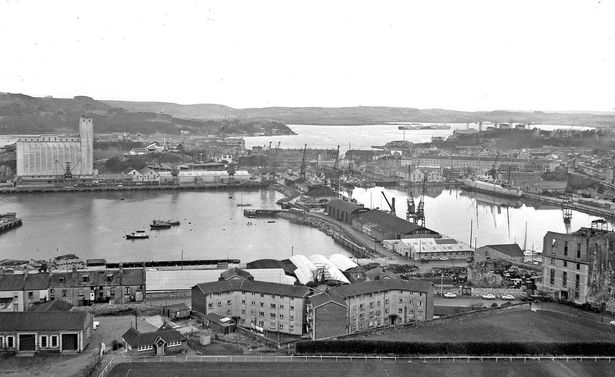
“Activities were sailing, canoeing and rock climbing. We both enjoyed the sailing so, when we were given a choice of activity on the final day, we chose sailing. As this was the last day we dressed a little more warmly because we didn’t have to think about all our clothes being wet the next day. Neither of us could swim but the boat felt safer and I remember the sun sparkling off the wavelets, so the days we went out in it must have been good weather. I remember daydreaming, watching a bug that had flown onto the gunwhale next to me then onto my hand as I steered, it was such a lovely day. ‘WHACK’ the instructor hit my hand hard ‘Watch what you’re doing, this is a serious business!’ He was quite right, of course.

Canoeing was awful, in my memory. We couldn’t swim and Mum had told us that the grey flannelette type short sleeved shirts she’d packed for us ‘were for the canoeing’. So that’s what we put on. Neither of the instructors told us to go back in and put on something warmer or offered us something else to wear and, of course, there were no lifejackets. So we went out wearing shorts, plimsolls and the short sleeved shirt. It was freezing and wet. Bob managed the morning’s canoeing but collapsed with hypothermia towards the end of the afternoon, we were so cold and wet in those thin grey short-sleeved shirts. I remember shouting to the instructor because I was frightened and angry. I remember one of the instructors taking off his zip up top and putting it around Bob’s shoulders as he was helped and half carried back to the accommodation block at the end of the day. Don’t remember any other fuss, after he warmed up it was back to normal. They’d put me and Bob in the same two man canoe as a safety measure because neither of us could swim. So I paddled us back after he couldn’t do it anymore. One of the most vivid memories of canoeing was how terrified we both were when the instructor told us all we were going to ‘raft up’. This entailed manoeuvring each canoe next to each other and grasping the paddle of the one next to you to make a raft. Then the two outboard canoes swapped occupants. We were frightened enough with just the canoeing (I don’t think people appreciate just how terrifying water is to kids who can’t swim.) but the rafting added a whole new dimension of terror. And we had to do it, the instructor was insistent. I was really frightened but that didn’t matter. ‘GET OUT OF YOUR CANOE, BOY, AND WALK ACROSS TO THE OTHER OUTBOARD ONE!’ To be fair to the bloke, maybe he didn’t realise we couldn’t swim?”. The Instructors were generally a mix of newly qualified young adults after a bit of adventure and ex military. It sounds as if Mark and Bob got one of the ex military some of who seemed to treat it as a bit of training or boot camp rather than an Adventure Centre.

“The irony is that our younger brother learnt to swim in the time we were away on the island! So we learnt, right after, too. Anyway back to the canoeing; we did the walk across the raft, scared witless though we both were, then the group paddled over towards Cawsand. Here the proper canoe instructor (the one who later gave Bob his top) demonstrated a barrel roll (also known as an Eskimo Roll) meaning he flipped over 360 degrees, under the water and back up again. The instructor’s canoes had splash decks, obviously ours didn’t. In my memory we split into two groups (ish); not sure if this was planned or it just happened that the other instructor (GET OUT OF YOUR CANOE, BOY one) was next to me and Bob. Anyway he attempted a barrel roll but, although his paddle appeared several times swirling about, he didn’t. I remember thinking ‘Oh he’s going to drown.’ So we sat in the canoe and watched until the other instructor realised what was happened and came racing across to pull him up into the air again. We also rock climbed; first of all on the island to practise technique, then Shaugh Prior up on the moors. In our memories we were taught, initially, that we couldn’t fall off so there was nothing to be frightened about. We all had to climb a buttress and, half-way up told to let go so we could see how the safety rope would arrest our fall. Bob did all these sort of things first so he, obediently, let go. Fell a foot or so but then was out of synch with the foot and hand-holds so remembers scrabbling about trying to reach them. I remember no problems with me doing it. Then it was abseiling, we had to abseil over one of the gates and down to the ground. This gate had an overhang at the top so the idea was that once your feet were on the top of the overhang moulding you would thrust off whilst simultaneously letting the rope through your hands to get below the lip so you could swing yourself in and carry on the descent. No safety helmets back then. If you didn’t let out enough rope, as you pushed off, then you’d swing back in and crack your head on the gate overhang. Bob realised this, ducked, and smacked his shoulder instead. Neither of us minded the rock climbing though because the instructor inspired confidence, he knew we could do it… so we did. This was the instructor that had smacked my hand when I was daydreaming out in the whaler”. Seems in the early days some of the instructors were dual rolled for instructing which in the early days with smaller numbers would make sense. Later on as Health and Safety regulations kicked in helmets and other safety equipment was used.
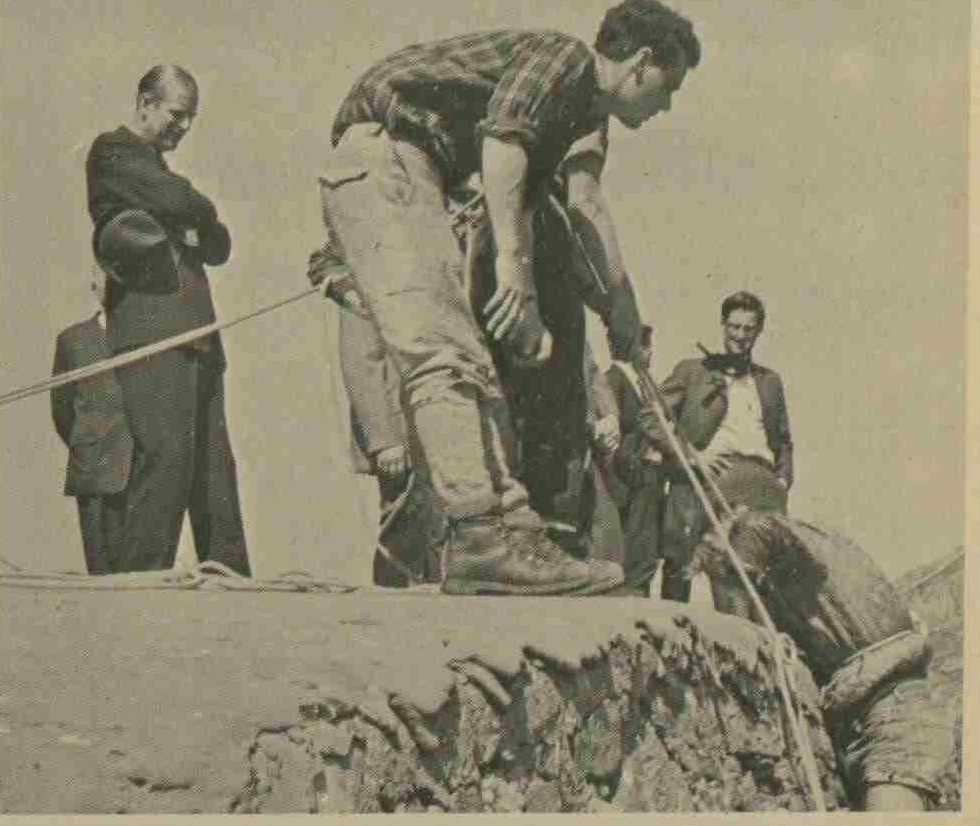
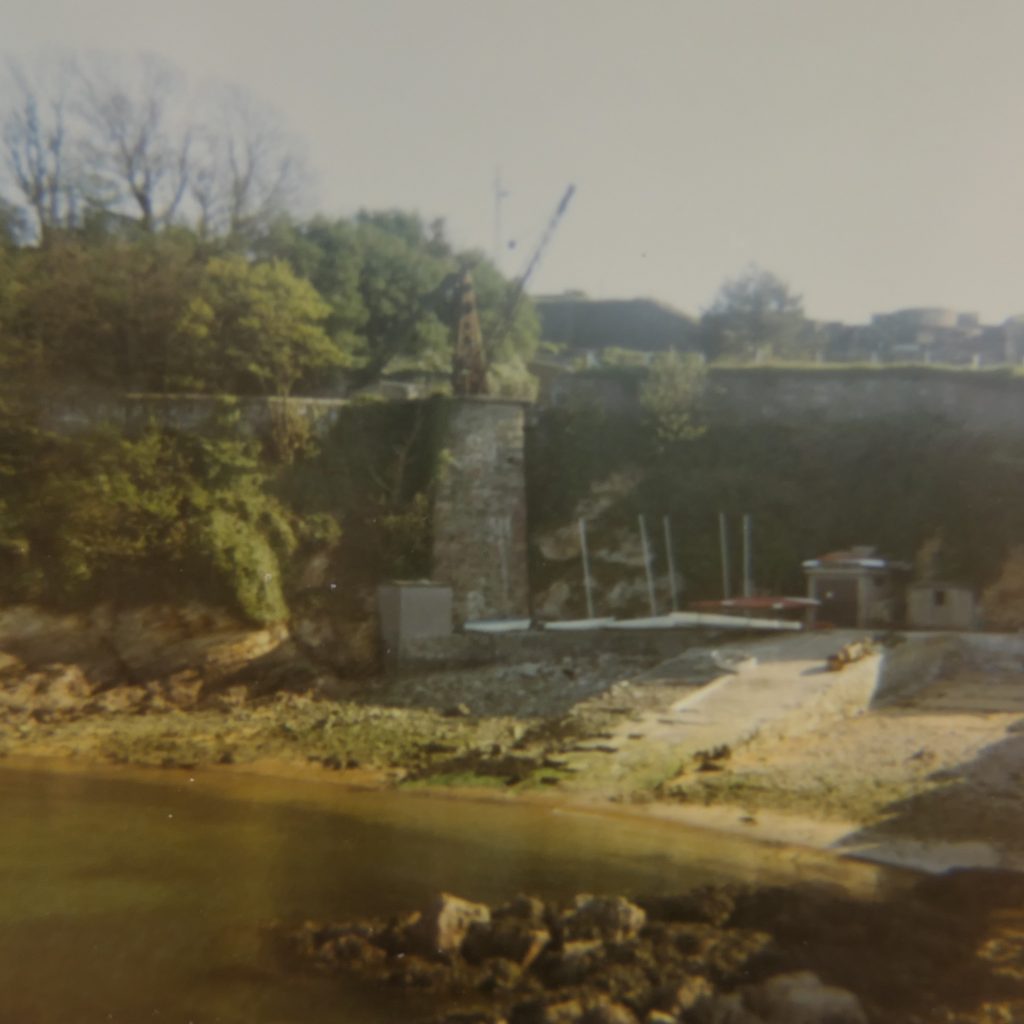
“I don’t remember it frightening me although I do remember one of the Danish boys freezing halfway up one of the buttresses and it being a hell of a job getting him to safety. They had to go down and persuade him to let go the handholds he had gripped onto. After lunch we went over to the mainland and up to Shaugh Prior to practise climbing real rock. Again the instructor showed us the way first; two thirds of the way up he stopped on a narrow ledge to inform us that this was ‘a good spot for a breather’, took out his pipe, filled it, lit it, puffed away for a minute or two then, after tapping it out, continued to the top. Bob went first, as usual, and that ledge was a good place for a breather, you could see for miles and miles. There was another wrinkle with regard to the food; which was good and lots of it. Bob was a vegetarian so he filled up on beans, potato, vegetables etc and doesn’t remember being hungry as that was what we mostly ate at home. We had to take it in turns to do our stint washing up, cleaning the dining room etc. It was here I learnt the institutional way of drying dishes. As I picked up one to dry it the bigger boy (or hulking great brute) next to me asked what on earth I was doing? ‘Oh God, what have I done now?’ I thought. I was on my own as Bob and I had different duties that day. He looked at me, smiled, then said: ’Look, pick up four at a time and dry the top one and the bottom one. Then put them in the rack OK?’ I must have still looked puzzled because he explained: ‘Then we’ll be out of here in half the time… see?’ And we were. We enjoyed a lot of our time on the island and the bits that scared us witless were lessons too”.

There were also day students who would travel to the Island on a daily basis for a weeks adventure training, Richard Metters was one. “I went to a primary school in a deprived area of Plymouth in the 70s and thought Christmas had come early when we had the opportunity to go to Drake’s Island every day for a week. Every day we’d catch a bus to the Barbican and then a boat over to the island, get off on the jetty and run up to the building area to find out what the activity we were going to do that day. One day we were thrown in a canoe and spent the morning learning how to manoeuvre it and how to right ourselves when it capsized. In the afternoon we canoed around the island as the tide was going out and one of our group got stuck on the sand whilst trying to take a short cut on the Cornish side of the island. Another day we learnt to sail dinghies and sailed around the breakwater trying very hard not to get close to the massive rocks that form the base of it, another we did rock climbing and abseiled down the wall at the back of the island as well as clambering around the whole of the island for the rest of the day. The best day by far was the caving day where we went into the tunnels under the Island and explored all the nooks and crannies. The only activity that I couldn’t take part in was the diving one as I have asthma and wasn’t allowed so spent the day eating food and watching everyone else do it. I seem to remember that in the morning we did snorkelling around the jetty and then in the afternoon we had to put on lead weights around our midriff and walk down the rickety steps into the sea, of course at high tide! As I say I wasn’t allowed to do that so watched everyone else with trepidation to see if they would actually come back up! I think that the instructors were a mix of ages, but none that were very old. I think that the more active we were the younger the instructors! Our class size was around 25 and I am pretty sure that when we did some of the activities, sailing and rock climbing for definite, there were other schools there which probably doubled the contingent. I think there were at least 20 dinghies out on the Sound and each had at least 2 children in them. The canoes were kept on site in a big shed, which is maybe where they kept the dinghies too – I don’t remember how they got to the shore for us to get in. The rock climbing consisted of some old rope and carabiners which did nothing to think that I’d be kept safe in any way, and for the caving we had the same rope so we couldn’t stray and hard hats with lights on that were kept on the inside of the big double doors opposite the main building”.
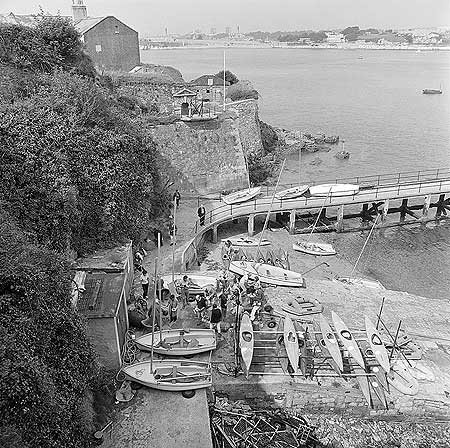
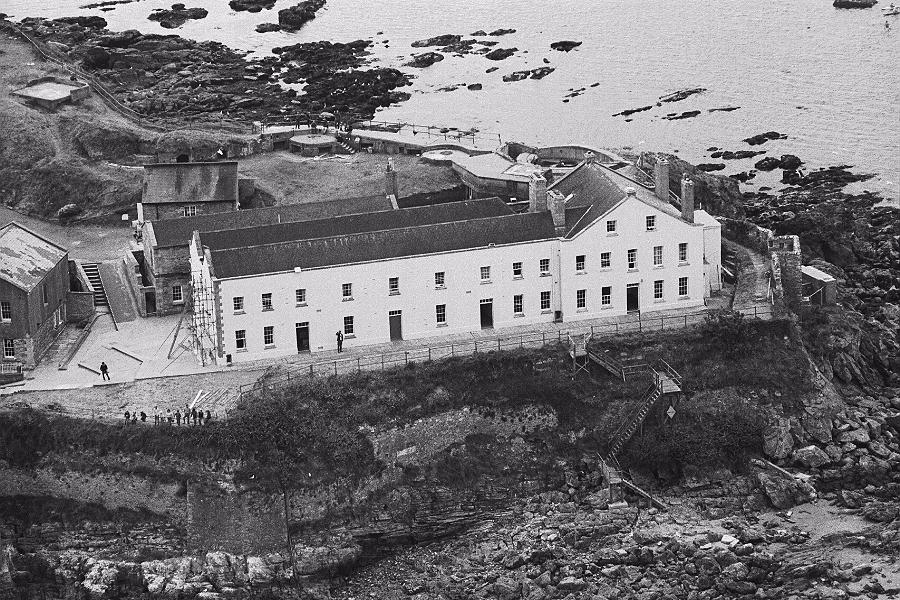
The Island Committee roped in whoever they could to help develop the Island. As part of that legacy Barry Dunridge left his mark on the Island “The crane on the end of the pier was put there by dockyard apprentices in 1972 if my memory serves it was a whaler davit from a frigate I know because either my name or initials are written into the concrete base”.
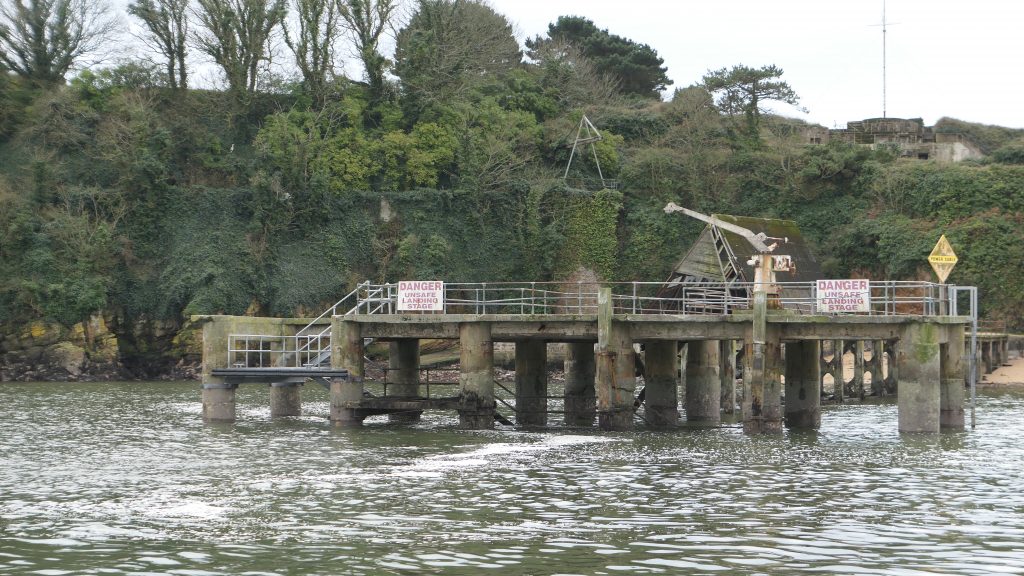
Fergus Parsons worked as the Island Bosun with responsibility for the Island’s three work boats. He was employed full time and lived on the Island. “I worked and lived on Drakes Island as Bosun for three years including two winters from 1974 to 1977. My job was to look after the three motor boats. The first a 30 foot launch known affectionately as Choccy and was used as a ferry between Mill Bay docks and the Island. The second boat, called Little was an open clinker built 25 foot workboat. (Clinker means the wooden slats of the hull overlapped rather than butted up smoothly) The third was a 12 foot safety boat used for escorting sailing dinghies. Apart from running the ferry 3 times a day, I was also responsible for the bosons locker where all boating gear was kept. School groups of up to 40 children would start arriving from April to September to take part in outdoor activities. About 10 instructors and four kitchen staff all lived and worked on the Island during the season. In winter time it was just me! Being an Island posed many a problem, ferrying food supplies from Mill Bay Dock was always a team effort. Maintenance of boats and gear, buildings and equipment was always an ongoing job and often arranging for materials and sometimes specialist work to be ferried in. During my second winter there the water pipeline from Mill Bay broke, thankfully it rained a lot till fixed! The weather was always taken into account with a daily forecast every morning from RAF Mountbatten. Sometimes in a gale with wind over tide it was impossible to get to Mill Bay even in a 30 foot launch! I remember the cast iron crane above the slipway, originally used for craning up ammunition”. There were a couple of breaks in the Water Pipe over the Island’s history. On the occasions it happened water was bought over in jerry cans or similar and carried up to the Island.
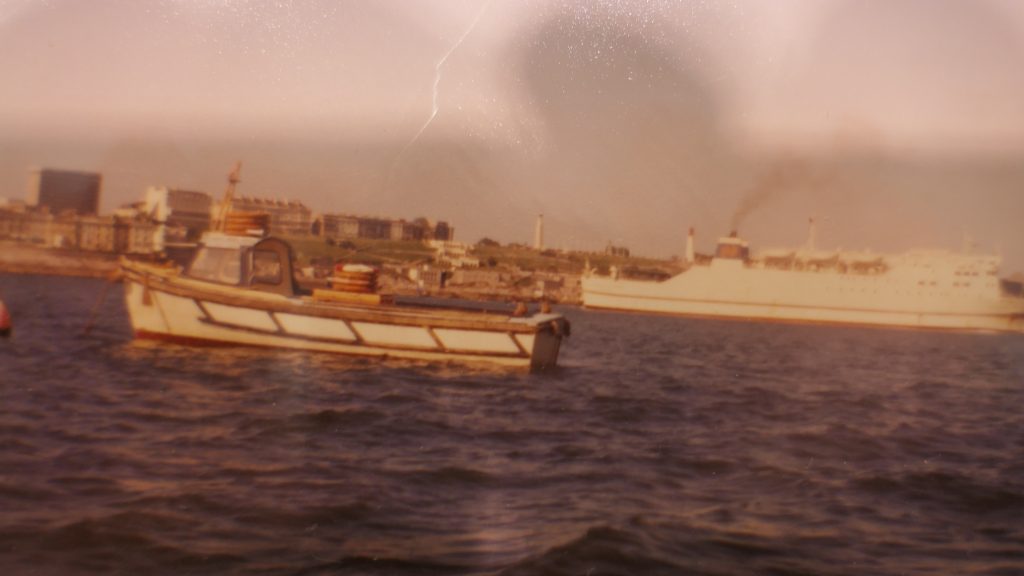
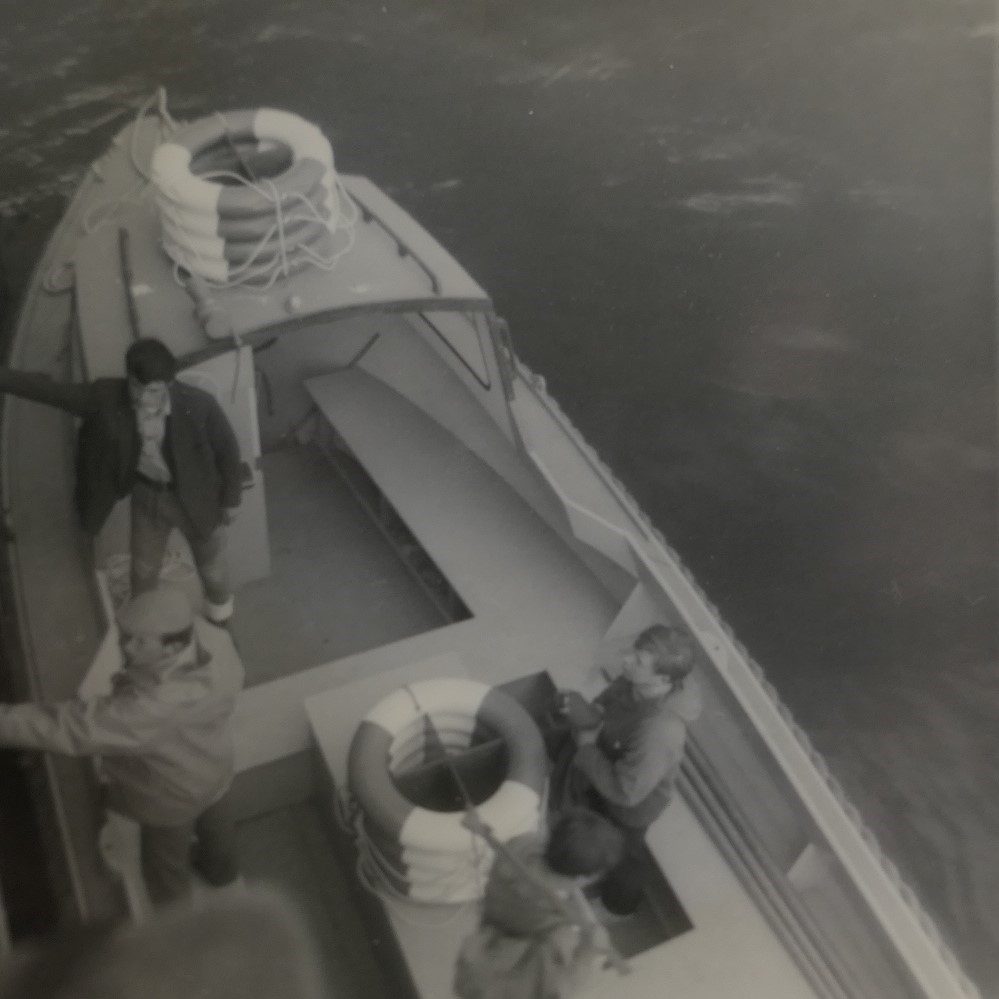
Various committees supported the Centre and a group called the Friends of Drake’s Island also used the Island for Fund raisers. Eileen Breheny attended one “I went to a medieval feast there one evening.it was such a long time ago in the middle 70s sometime…I have no idea who organised it as we went with my Niece who invited us to go. All I remember is we went by boat and 1 think it was all underground because we were in like a massive room like a cave with dome shaped roof. Food like in Henry VIII time which you ate with your fingers. First time I ever went there. The only other time I went there was with a Playschool around 1984…We spent a few hours there. There is a lovely beach, proper sand”. Sounds like the Feast was held in the old Underground Magazines on the lower level. It was most likely organised by the Friends of Drake’s Island. They also ran annual Armada Suppers on the Island for a while.
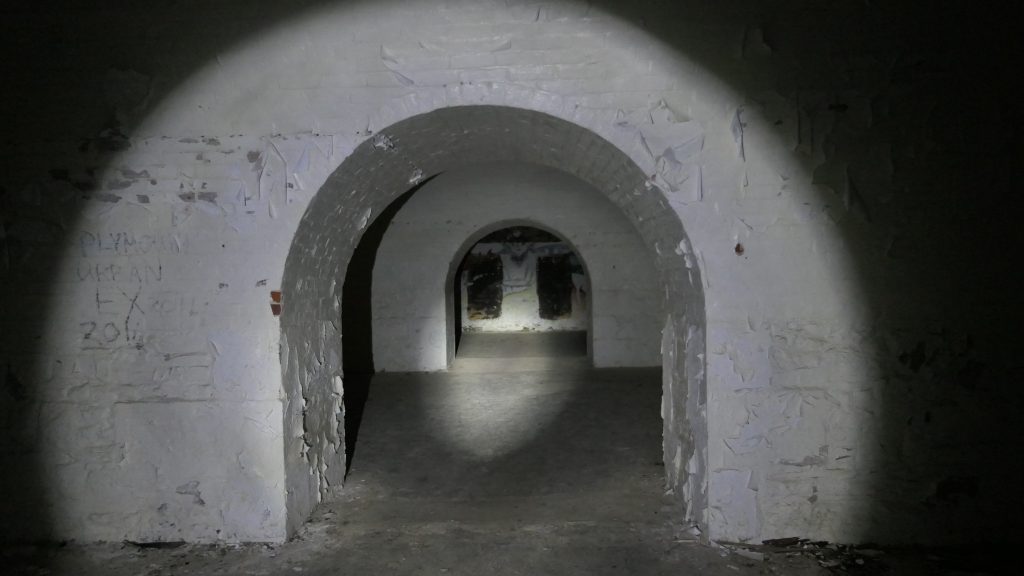
In 1979 one of the unused Casemates was adapted for the staff as a base for the Youth Opportunities Programme commonly known as the YOP Scheme. Tony Brelsford was one of those who took part “Great place, did my YOP (Youth Opportunities Programme) Scheme there as a canoe builder won’t forget winter months riding my purple FS1E to Mill Bay docks to get on the boat”. An FS1E was a 49cc Yamaha Bike affectionately known as a Fizzy.
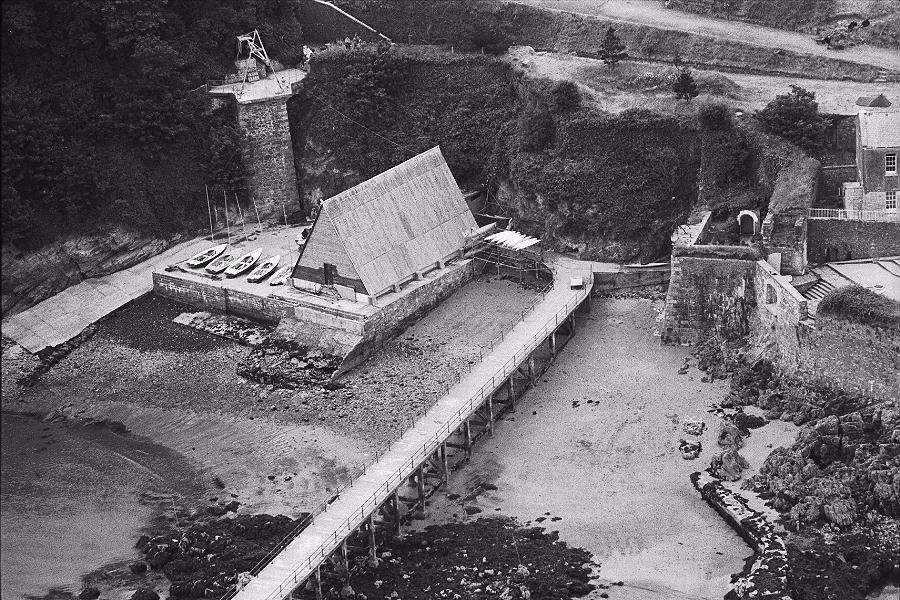
The staff situation was often quite fluid with personalities from the Warden down having an influence. The Warden was one of the few well paid, far above the average wage for the time whereas most of the staff were well below the average. The recruitment was nothing like today as Phil Jaquiery, a Kiwi discovered when he applied for an instructor job around 1980. “I remember my job interview as an adventure training instructor: the Aussie interviewer said, “So you’re the Kiwi, are ya? You’ll be alright.” I was on crutches at the time with a broken ankle, having recently crashed a microlight aircraft. I also remember that we used to take groups of kids across to the Hoe in kayaks and one time the Grockle boat pulled in. The kids were bugging me to do an eskimo roll and I really didn’t fancy it in those waters (full of oil and detritus) but the kids kept on and shouted to the Grokles that I was going to do a roll. The Grokles lined the rail, watching, and the clamour intensified so I rolled. I rolled so enthusiastically that I very nearly capsized again”. Grockles for those who don’t know are visitors to the South West not from the local area, so holiday makers on a tourist boat. Interesting how dirty the Sound still was, there were complaints in the newspapers all the way back to the early 1800’s about the unhealthy state of the Sound. Throughout the Adventure Centre years although sewage was treated in tanks by microbes there was still overflow and into the Sound and grey water was discharged directly as well. We also know from the Centre records when the sewage tanks were fouled they were dug out and the waste simply buried on the beach.
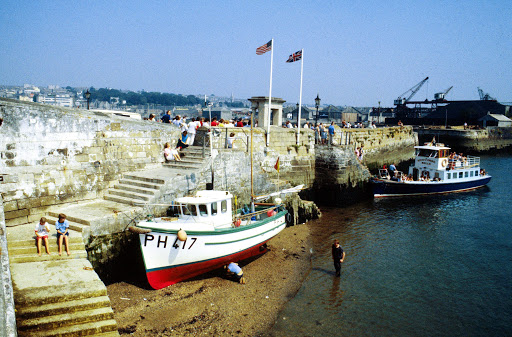
Typically for young workers it wasn’t all work and no play. For any group of young adventurers there is always a party to be had and a club to be clubbed as Neil Young who was an instructor on the Island recollects “I worked there for a year 1982, spending a few winter Months on the island when it was empty. The fun bit was getting back to the island drunk at 2 am from the angling club on the Barbican. There would be a duty boat driver who would not wait if you were late. Then there was a 30 minute often rough and very wet trip back to the Island. That year the Council had invested in new beds in the dorms and also 12 new bright yellow perception dancer kayaks. It was mostly lots of maintenance, a full time boatman/caretaker was on the island most of the winter. I had a few nights on my own there when storms made it unsafe to land you were stuck…a little spooky. Some nights we would kayak to Mill Bay hide the kayaks, get changed and go clubbing. Paddling back very drunk was interesting sometimes”.
In later years the underground magazines on the lower level became a club for the students on the Island. As I’ve said previously some of the committee were concerned about the flirting in what they called the Snoggery. Maybe they had a point as Monica Bell recalls “Speaking of things that wouldn’t happen today – in 1986 on a school trip, a 13 year old female student (not me!) and a male instructor were all ‘lovey-dovey’ at the campfire on the last night and all the grown ups thought it was so funny. Niki and Charlie were their names. I still remember the chanting of their names. The guy was probably only 18 but I remember thinking it was SO cool. As a mother now I’d be horrified. Different times indeed but so much fun and adventure! It is where I discovered my life-long love of kayaking”.
These are just some of the great memories that I’m so glad we can preserve as part of the Island’s social history so many thanks for all who have shared their time on the Island. Next week some more memories from two instructors who were on the Island in the 1980’s.

Great memories. I lived there in 1986 with my mum for a year including 2 harsh winters which was an experience. I wasn’t employed there.
My mum Pat helped run the island with Eric Parkinson the warden.
I was the ‘male instructor’ aged 17, and Nikki was 16, she was American from Greenham Common airbase. I saw her for a year after, I cycled several times the 200 miles to see her.
Can’t believe someone could remember those details!
Amazing to hear from you Charlie and thanks for adding to the story. Our first public tour after the lockdown eased was for the Drake’s Island Adventure Centre Staff and Students Vets which was a great morning of reminiscing as we walked around the Island. Our events organiser Cathie is looking at doing another one later in the year and the details will appear on the Drake’s Island facebook page https://www.facebook.com/DrakesIslandUK if you want to keep an eye for it. We do currently run tours as well and the details are on the same page.
Haha, charlie you had to put thet story straight or be remembered as a pervert!
That was a long cycle for any girl’s affection.
I went to drakes island in the 70’s, when you were in Japan with the Navy.
All I realy remember is on the tour, there was skeleton in the cage hanging up, well I was only 6 or 7 years old and that was the most memberable thing on the island.
I would have loved to live on the island.
Hi Charlie ! I was the Manager of the Mayflower Centre in 1986 and I remember Eric Parkinson and your Mum Pat coming over to collect mail etc several times a week. For the life of me I cannot remember Pats surname and it has been bugging me for sometime! Please put me out of my misery ? Thku